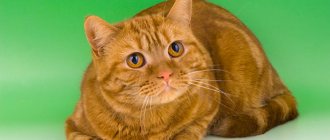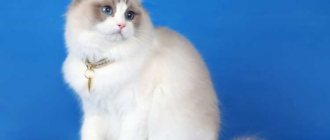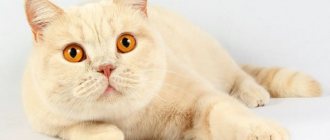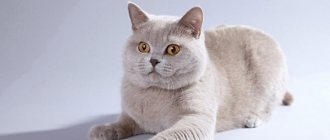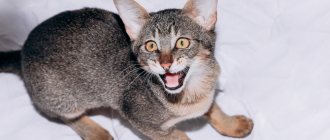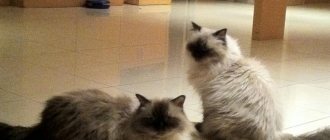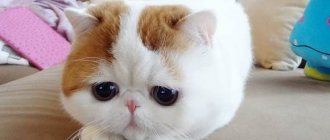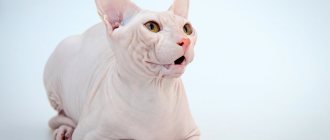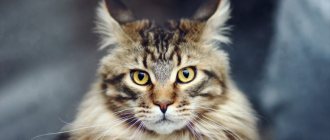To breed the fiery coat color of British cats, breeders used Persian genes. Getting a uniform color proved to be a challenge. Test work continues.
Ginger British cats gained worldwide popularity at the end of the 19th century thanks to the unusual color of their fur coat, plush to the touch, and the surprised look of their large eyes. British cats have a large, muscular body, not inferior in grace to any other breed.
Features of color
At exhibitions, strict requirements are put forward for pets. A Briton with a uniform, rich red color is allowed to participate. The hair is uniform throughout its length. The standard allows partial tabby coloring on the forehead in the form of the letter “M”, paws, and tail; inclusions in the form of white wool are rejected. The paw pads and nose are a brick-red, terracotta shade a tone darker than the cat's fur. Eye color is red and yellow.
British shorthair
The British Shorthair cat is characterized by a plush coat, round eyes and small ears. The coat is harsh, dense with a thick, uniformly colored undercoat. Soft is a disadvantage.
Exhibition activities of red British cats
Any red British cat can participate in cat shows if it meets the required breed standards, is completely healthy, vaccinated and has no clearly visible physical defects or defects. It is necessary to have the necessary set of documents (veterinary record, pedigree, etc.).
The following individuals are rejected (disqualified):
- with a lighter fuzzy undercoat;
- having any white or light spots, inclusions, stripes, etc.;
- the pads on the paws and nose are not brick-red in color or have spotting on them;
- eyes that are not yellow or have a green rim around the iris;
- jaw defect (overshot or underbite over 2 mm);
- creases or bends in the tail;
- insufficient or excessive number of toes;
- problems with the coat (sparse, weak undercoat, too soft and fluffy, etc.).
The show animal must meet all breed standards
It is necessary to prepare for such public events in advance:
- The pet is bathed 2-3 days before the exhibition. It is better to use a special shampoo and conditioner (to give the coat a healthy shine).
- Carefully trim and file the claws on the paws.
- Rub the eyes and ears.
- The day before, brush your teeth with a special paste and brush.
You cannot tint or tint an animal's fur; the owner will be punished for this (disqualification). Experts are very loyal to red-haired British dogs and allow some errors in their coat.
To prevent cats from getting nervous and panicking at shows due to the large number of strangers scurrying around and trying to touch them, it is recommended to give your pets a special sedative. When I attend such events, I sometimes see bottles in the hands of the owners. But gradually the animals get used to it, and then the need for this disappears.
Video: Golden Briton at an exhibition
Red-haired British dogs are very rare, especially bright ones, and therefore cannot be cheap. You should purchase such a kitten only from a specialized nursery or from a reliable, trusted breeder with good recommendations. In this case, it is necessary not only to check the documents for both parents, but also to look at them personally. Otherwise, you can get an ordinary outbred saffron milk saffron, passed off as a purebred animal.
lop-eared british
Representatives of the Scottish breed have kittens with straight ears. The fold-eared cat becomes later. They are often confused with the British. The breeds are really similar. However, red-haired Britons have small, wide-set, straight ears. The red fold-eared British cat is a myth.
red british cat photo
How to get color
The genetic feature of the fiery color is the impossibility of obtaining a cat of a single color. The tabby pattern is always present, although not pronounced.
Red (cream) color is usually denoted by the letter “O”, meaning red (orange). The "O" mutation is found on the female "X" chromosome. Such a gene is called sex-dependent.
The brightness of the color depends on the “D” gene: with the dominant gene (D), the pigment lies evenly, the kittens are bright red; with recessive (gene d) - vice versa: cream.
It is possible to determine whether a carrier has the gene for the required color using genetic tests.
Red color gene
Like humans, females have two X chromosomes (XX), while males have one (XY). It turns out that a fiery-colored cat is much less common.
Genetic color formula:
- OO DD/Oo DD – cat/cat of bright red color;
- OO Dd/Oo Dd – a cat/cat of a bright red color, but they are carriers of a cream color;
- OO dd/Oo dd – cream-colored cat/cat.
Example:
- The pair OO DD + Oo DD will give birth to bright red kittens.
- In the pair OO Dd + Oo Dd, no more than a quarter of the offspring will have a cream color.
- The pair OO dd + Oo dd will give birth to kittens with only cream coat color.
The probability that ginger cats with Oo dd and Oo dd formulas will give birth to kittens with a color different from their parents is 25%.
kittens
Little British Reds come in both short-haired and long-haired varieties. The richer the color of a kitten’s coat, the higher its value. Sometimes white hairs are observed on the body. If they do not disappear with age, then there should be no talk of any exhibitions. Usually kittens are born with tabby markings, but with age the pattern becomes almost invisible, and it is called monochromatic.
To maintain bright color and shine, cats' fur is washed twice a month. To avoid damage to the skin and undercoat of a ginger cat, combing with tools with hard metal teeth is not recommended. Soft, silky wool is a minus. According to standards, babies should have a thick, moderately hard undercoat.
The color of the nose is red. Particular importance is paid to eye color. An iris of orange, copper, and gold colors is welcome. Green is not allowed for exhibitions.
Diseases
Despite a strong immune system, if not properly maintained, a cat may encounter some diseases.
- Obesity. Excess weight appears in conditions of physical inactivity against the background of abundant nutrition, excess consumption of fatty and protein foods. To get rid of fat deposits, you should play with the cat more, let your pet go for walks, and adjust the diet.
- Nail fungus. Timely trimming of nails and constant care for their condition will help prevent the disease.
- Hair loss. Shedding can be triggered by allergies or damage to internal organs.
- Tartar. As a preventative measure, you can periodically give your pet dry food. It is necessary to monitor your cat’s oral hygiene: brush its teeth. If symptoms of tartar appear (bleeding gums, increased salivation, putrid odor from the mouth), the help of a veterinarian will be required. If left untreated, your pet's teeth will begin to fall out.
- Eye irritation. Redness of the proteins indicates the development of an allergic reaction, injury or the appearance of conjunctivitis. For this reason, the cat needs the help of a veterinarian - a specialist will prescribe eye drops.
- Gastrointestinal disorders. It is necessary to monitor the quality of food and the condition of the cat. If your pet is lethargic, you should pay attention to his stool. There may be blood clots in the feces, which indicate the development of internal bleeding. Various parasites can enter a cat's body along with food.
Among the inherited diseases, hypertrophic cardiomyopathy stands out. In such a situation, it is recommended to sterilize the cat to reduce the risk of developing this pathology in kittens. Elderly individuals may develop urolithiasis, plague, and calcivirosis.
Most diseases can be cured with medication or surgery.
Who would suit a red-haired Briton?
Many people think that color does not affect character. Breeders have a different opinion: British redheads are considered to be real aristocrats. They do not bother their owner by meowing. They don’t get in their way when begging for anything. They are reserved and independent. They lead a sedentary, quiet lifestyle.
Smart by nature. They become toilet trained instantly, all you have to do is show the kitten the litter box once. British cats are clean and do not require careful, long-term care. Cats have good health.
British ginger cats are attached to their owners, but are not known for their affection: they rarely allow themselves to be stroked and do not sit on laps. They get along with both children and animals: a dog will become a good friend for a Briton. They play with children according to their mood, often ignoring them. When a person pays increased attention to his person, he will not release his claws and will prefer to leave. They love solitude, and therefore are suitable for busy and business people.
Advantages and disadvantages
The advantages include the British cat's calm character, cleanliness, and ability to get along with any family member, including other pets.
Good mental abilities are also a plus: cats understand prohibitions the first time.
About the disadvantages: red color in British cats is very rare. Often there is an uneven color with white spots on the tail, paws, and chest. Such cats are beautiful, but they will not be allowed into the exhibition.
The disadvantages include heavy shedding at least 2 times a year. During this period, special attention should be paid to hair care. It is recommended to comb out at least once a week, and with the onset of winter, this procedure is carried out daily.
The sedate lifestyle of a British breed cat is fraught with obesity. It is necessary to monitor portion sizes, play with your pet, and walk it.
The right approach to feeding
Having given preference to natural nutrition, it is necessary to include raw lean meat in the animal’s diet.
An important aspect of keeping British cats at home is a healthy diet. Tawny British kittens up to six months of age should receive food at least 5 times a day. Older pets are fed twice a day: morning and evening. Description of the basic rules of proper nutrition for the British:
- fresh food;
- food at room temperature;
- feeding at the same time;
- removing leftover food from the bowl;
- the presence of a cup of clean water next to the food plate.
As for the products for feeding the British, it is allowed to feed the pet with store-bought food, but many owners prefer to pamper their cats with natural food. An unbalanced diet can harm the animal. The menu of British cats includes lean raw meat. The product is pre-frozen for 2 days to get rid of pathogenic microorganisms. Preference is given to beef, which is cut into small cubes along with films and veins. It is permissible to give such meat daily. This food improves chewing reflexes and protects teeth from the formation of tartar deposits.
It is allowed to include turkey, chicken, and rabbit in food. The British also love offal, especially liver. Boiled fish and fermented milk products are allowed in limited quantities. This food will provide the body with the required nutrients and vitamins. It is useful to add porridge, eggs and fresh vegetables to the menu.
